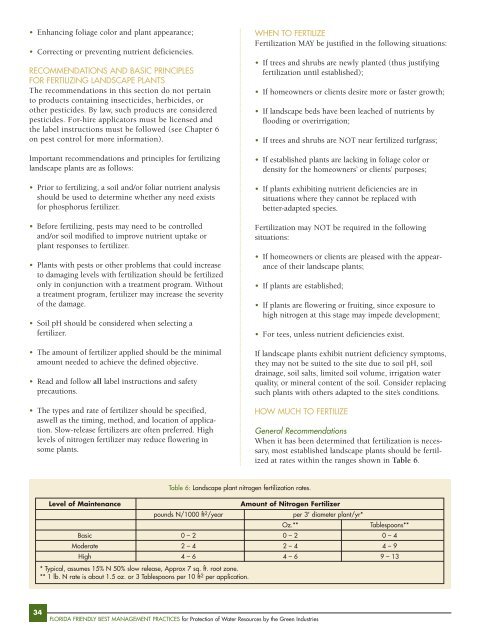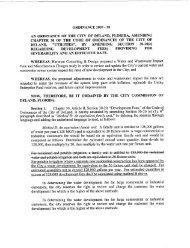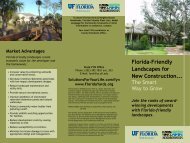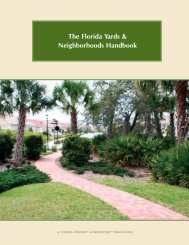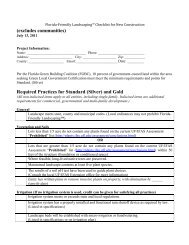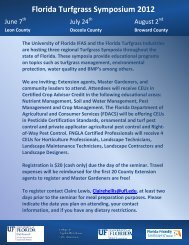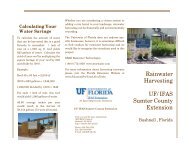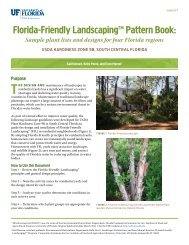• Enhancing foliage color and plant appearance;• Correcting or preventing nutrient deficiencies.RECOMMENDATIONS AND BASIC PRINCIPLESFOR FERTILIZING LANDSCAPE PLANTSThe recommendations in this section do not pertainto products containing insecticides, herbicides, orother pesticides. By law, such products are consideredpesticides. For-hire applicators must be licensed andthe label instructions must be followed (see Chapter 6on pest control for more information).Important recommendations and principles for fertilizinglandscape plants are as follows:• Prior to fertilizing, a soil and/or foliar nutrient analysisshould be used to determine whether any need existsfor phosphorus fertilizer.• Before fertilizing, pests may need to be controlledand/or soil modified to improve nutrient uptake orplant responses to fertilizer.• Plants with pests or other problems that could increaseto damaging levels with fertilization should be fertilizedonly in conjunction with a treatment program. Withouta treatment program, fertilizer may increase the severityof the damage.• Soil pH should be considered when selecting afertilizer.• The amount of fertilizer applied should be the minimalamount needed to achieve the defined objective.• Read and follow all label instructions and safetyprecautions.• The types and rate of fertilizer should be specified,aswell as the timing, method, and location of application.Slow-release fertilizers are often preferred. Highlevels of nitrogen fertilizer may reduce flowering insome plants.WHEN TO FERTILIZEFertilization MAY be justified in the following situations:• If trees and shrubs are newly planted (thus justifyingfertilization until established);• If homeowners or clients desire more or faster growth;• If landscape beds have been leached of nutrients byflooding or overirrigation;• If trees and shrubs are NOT near fertilized turfgrass;• If established plants are lacking in foliage color ordensity for the homeowners’ or clients’ purposes;• If plants exhibiting nutrient deficiencies are insituations where they cannot be replaced withbetter-adapted species.Fertilization may NOT be required in the followingsituations:• If homeowners or clients are pleased with the appearanceof their landscape plants;• If plants are established;• If plants are flowering or fruiting, since exposure tohigh nitrogen at this stage may impede development;• For tees, unless nutrient deficiencies exist.If landscape plants exhibit nutrient deficiency symptoms,they may not be suited to the site due to soil pH, soildrainage, soil salts, limited soil volume, irrigation waterquality, or mineral content of the soil. Consider replacingsuch plants with others adapted to the site’s conditions.HOW MUCH TO FERTILIZEGeneral RecommendationsWhen it has been determined that fertilization is necessary,most established landscape plants should be fertilizedat rates within the ranges shown in Table 6.Table 6: Landscape plant nitrogen fertilization rates.Level of MaintenanceAmount of Nitrogen Fertilizerpounds N/1000 ft 2 /yearper 3' diameter plant/yr*Oz.**Tablespoons**Basic 0 – 2 0 – 2 0 – 4Moderate 2 – 4 2 – 4 4 – 9High 4 – 6 4 – 6 9 – 13* Typical, assumes 15% N 50% slow release, Approx 7 sq. ft. root zone.** 1 lb. N rate is about 1.5 oz. or 3 Tablespoons per 10 ft 2 per application.34FLORIDA FRIENDLY BEST MANAGEMENT PRACTICES for Protection of Water Resources by the <strong>Green</strong> <strong>Industries</strong>
The P content of the fertilizer should be zero unless a soilor tissue test indicates a need for additional phosphorus.Historically, the ratio of N to K for landscape plants hasbeen in the range of 1:1 to 2:1. Since magnesium (Mg)deficiency occurs in certain landscape plants in manyparts of the state, up to 2.5 pounds Mg/1000 ft 2 /year maybe applied to address this problem. Micronutrients can beapplied at specified rates and timing to achieve fertilizationobjectives.In general, slow release fertilizers are horticulturallyand environmentally preferable for landscape plantings.Water-soluble fertilizers should be applied at a rate ofno more than 0.5 pounds N/1000 ft 2 per application.The maximum application rates for controlled-releasefertilizers depend on the percent that is water solubleand the release rates of the product. Never broadcastfertilizers on newly bedded plants. Apply the appropriateamounts to the individual plant within the area underthe plant canopy, which usually indicates the majorroot area.For additional information on landscape plants grown insoil, see IFAS Publication SL-141, IFAS StandardizedFertilization Recommendations for EnvironmentalHorticulture Crops, at http://edis.ifas.ufl.edu/CN011.PalmsPalms have different nutritional requirements than mostother landscape plants. In Florida’s rock, muck, andsandy soils, palms may be especially prone to K, Mg, Mn,Fe, and B deficiencies. If you suspect deficiencies in apalm tree, take a leaf to your Cooperative ExtensionService agent for assistance. In general, fertilizers or supplementsshould be applied to supply N, P, K, and Mg atabout an 8:2:12:4 ratio. The N, K and Mg should be in aslow-release form. In addition, 1 to 2 percent Fe and Mn,and trace amounts of Zn, Cu, and B, may be needed.For more information on palms and palm deficiencies,see Fertilization of Field-grown and Landscape Palms inFlorida, http://edis.ifas.ufl.edu/EP261 or NutrientDeficiencies of Landscape and Field-grown Palms inFlorida, http://edis.ifas.ufl.edu/EP273.WHERE AND HOW TO FERTILIZEFertilizer should be broadcast uniformly over thedesired areas of the landscape. Root location, fertilizationobjectives, and plant species should be considered.Areas where tree or shrub fertilization zones overlapwith lawn fertilization zones should receive one,not two, fertilizations. Start with the lowest recommendedrate and slowly increase to amount up to themaximum recommendation only if the plant requires it.Foliar applications, injections, or implants should onlybe used when the soil application of fertilizer is impracticalor ineffective in achieving fertilization objectives.When applying foliar fertilizer, the fertilizer solutionshould be thoroughly sprayed to cover the affectedfoliage at the proper stage of growth to achieveobjectives.Make sure your fertilizer spreader is properly calibratedand on the correct setting to deliver the desired amountof fertilizer for the area being treated. This is discussedin more detail in the section on calibrating pesticidespreaders in the next chapter and in the publicationbelow. For more information, see the following:IFAS Publication How to Calibrate Your FertilizerSpreader, IFAS Publication ENH 62, 2003. Available at:http://edis.ifas.ufl.edu/LH024.IFAS Publication Fertilization Recommendationsfor Landscape Plants, G.W. Knox, T. Broschat, andR.J. Black, IFAS Publication ENH 858, 2002.http://edis.ifas.ufl.edu/EP114.FERTILIZER STORAGE AND LOADINGIf not handled properly, fertilizers can alter or degrade theenvironment. Nutrients such as N and P in fertilizers canlead to the excessive growth of algae and noxious plantsin estuaries, lakes, and streams.Mishandling of fertilizers containing nitrates may resultin excessively high levels of nitrate in drinking-watersupplies (greater than 10 parts per million [ppm]ofNO 3 -N). This has been linked to health problems suchas blue baby syndrome (methemoglobinemia) in infants.Because the state’s aquifers and surface waters are extensivelyinterconnected, Florida requires all potentiallypotable ground water to meet drinking-water standards.For nitrate, federal and state regulations set the drinking-waterstandard at 10 ppm NO 3 -N. Shallow wells(less than 50 feet in depth) and old wells with faultycasings are at the highest risk for nitrate contamination.STORAGEAlways store nitrate-based fertilizers separately fromsolvents, fuels, and pesticides, since nitrate fertilizersare oxidants and can accelerate a fire. Ideally, fertilizershould be stored in a concrete building with a metal orother flame-resistant roof.Take care when storing fertilizer to prevent thecontamination of nearby ground water and surfacewater. Always store fertilizer in an area that is protectedfrom rainfall. Storing dry bulk materials on a concreteor asphalt pad may be acceptable if the pad is adequatelyprotected from rainfall and from water flowing acrossthe pad. The secondary containment of stationary liquidfertilizer tanks is addressed in Florida Department ofEnvironmental Protection Rules 62-761 and 62-762,Florida Administrative Code (F.A.C.). Even where notrequired, the use of secondary containment is soundpractice.Department of Environmental Protection – Revised DECEMBER 200835
- Page 3 and 4: GOALS OF THE MANUALThis manual prov
- Page 5 and 6: Table of ContentsGOALS OF THE MANUA
- Page 7 and 8: Chapter 1: IntroductionUSING BEST M
- Page 9 and 10: these is performed properly, the ne
- Page 11: BMPs, job safety, and the specific
- Page 14 and 15: compacted by construction activity?
- Page 16 and 17: promotes deeper rooting, which is o
- Page 18 and 19: Protection, water management distri
- Page 21 and 22: IRRIGATION SYSTEM INSTALLATIONOnly
- Page 23 and 24: tion promotes deeper root developme
- Page 25 and 26: GREEN INDUSTRY IRRIGATION BMPSThe p
- Page 27 and 28: MOWING THE FLORIDA LAWNMowing is an
- Page 29 and 30: MANGROVESThree species of mangroves
- Page 31 and 32: Chapter 5: FertilizationFERTILIZER
- Page 33 and 34: cases, these stabilized N materials
- Page 35 and 36: influences the activity of the soil
- Page 37 and 38: nitrogen restrictions discussed ear
- Page 39: impervious surface that drains to a
- Page 43 and 44: plastic container, mix them thoroug
- Page 45 and 46: think that less fertilization is al
- Page 47 and 48: help to establish proof of proper u
- Page 49 and 50: The best way to manage pesticide st
- Page 51 and 52: Segregate herbicides, insecticides,
- Page 53 and 54: pressure, size of nozzle, and spaci
- Page 55 and 56: MANAGEMENT OF PESTS IN THE LANDSCAP
- Page 57 and 58: ReferencesUnless otherwise mentione
- Page 59 and 60: Pruning Shade Trees in the Landscap
- Page 61 and 62: APPENDIX A: IMPORTANT TELEPHONE NUM
- Page 63 and 64: APPENDIX B: FLORIDA COOPERATIVE EXT
- Page 65 and 66: APPENDIX C: RULE 5E-1.003(2) LABELI
- Page 67 and 68: EMERGENCY REPORTING TELEPHONE NUMBE


